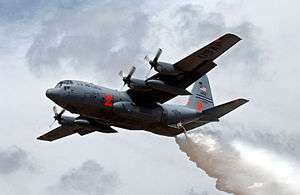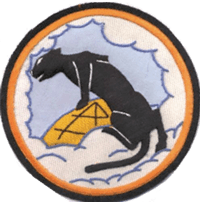731st Airlift Squadron
| 731st Airlift Squadron | |
|---|---|
 A squadron C-130 Hercules makes a drop during annual Modular Airborne Fire Fighting System training | |
| Active | 1942–1945; 1947–1951; 1952–1982; 1982–present |
| Country |
|
| Branch |
|
| Role | Airlift |
| Part of | Air Force Reserve Command |
| Garrison/HQ | Peterson Air Force Base |
| Engagements | European Theater of Operations[1] |
| Decorations |
Distinguished Unit Citation Air Force Outstanding Unit Award Republic of Vietnam Gallantry Cross with Palm[1] |
| Insignia | |
| 731st Airlift Squadron emblem (modified 22 July 1996)[1] |
 |
| 331st Bombardment Squadron emblem (approved 10 April 1943)[1] |
 |
The 731st Airlift Squadron is part of the 302d Airlift Wing at Peterson Air Force Base, Colorado. It operates Lockheed C-130 Hercules aircraft providing global airlift.
Mission
- Tactical Airlift
- Aerial fire-fighting for the U.S. Forest Service.
History
World War II
Activated as a Boeing B-17 Flying Fortress heavy bomb squadron; trained under Second Air Force. Completed training in early 1943; deploying to European Theater of Operations (ETO) assigned to VIII Bomber Command of the Eighth Air Force in England. Engaged in long-range strategic bombardment operations over Occupied Europe and Nazi Germany, March 1944 – May 1945 attacking enemy military and industrial targets as part of the United States' air offensive against Nazi Germany. Most personnel demobilized in Europe after the German capitulation in May 1945; squadron inactivated as a paper unit in November.
Reserve
Reactivated in 1947 as a Boeing B-29 Superfortress bomb squadron in the reserve, however equipped with trainers until 1949 when equipped with the Douglas B-26 Invader light bomber. Squadron activated in 1951 as a result of the Korean War; personnel and equipment assigned as replacements, then inactivated as a paper unit.
Reactivated in 1952 with RB-26 Invader photo-reconnaissance aircraft; Curtiss C-46 Commando transports; North Emerican F-51 Mustangs, and other second-line aircraft. In 1957, moved from Scott Air Force Base, Illinois to Laurence G. Hanscom Field, Massachusetts and re-equipped with Fairchild C-119 Flying Boxcars for tactical airlift. Activated during the Cuban Missile Crisis in 1962; returned to reserve status after crisis was resolved. In 1966, re-equipped with Douglas C-124 Globemasters for performing strategic airlift on a worldwide scale. Reassigned to various Air Force reserve wings; flying Fairchild C-123 Providers until inactivation in 1982. Reactivated in Colorado in the Air Force Reserve same date and equipped with Lockheed C-130 Hercules.
Lineage
- Constituted as the 331st Bombardment Squadron (Heavy) on 28 January 1942
- Activated on 15 June 1942
- Redesignated 331st Bombardment Squadron, Heavy on 20 August 1943
- Inactivated on 29 November 1945
- Redesignated 331st Bombardment Squadron, Very Heavyon 13 May 1947
- Activated in the reserve on 29 May 1947
- Redesignated 331st Bombardment Squadron, Light on 26 June 1949
- Ordered to active service on 10 March 1951
- Inactivated on 20 March 1951
- Redesignated 331st Tactical Reconnaissance Squadron on 26 May 1952
- Activated in the reserve on 14 June 1952
- Redesignated 331st Bombardment Squadron, Tactical on 18 May 1955
- Redesignated 731st Troop Carrier Squadron, Medium on 1 July 1957
- Ordered to active service on 28 October 1962
- Relieved from active duty on 28 November 1962
- Redesignated: 731st Military Airlift Squadron on 1 January 1967
- Redesignated: 731st Tactical Airlift Squadron on 1 October 1972
- Inactivated on 1 October 1982
- Activated in the reserve on 1 October 1982
- Redesignated 731st Airlift Squadron on 1 February 1992[1]
Assignments
- 94th Bombardment Group, 15 Jun 1942 – 29 Nov 1945; 29 May 1947 – 20 Mar 1951
- 94th Tactical Reconnaissance Group (later 94th Bombardment Group, 94th Troop Carrier) Group), 14 June 1952
- 94th Troop Carrier Wing, 14 April 1959
- 901st Troop Carrier Group (later 901 Military Airlift Group 901st Tactical Airlift Group), 11 February 1963
- 439th Tactical Airlift Wing, 1 April 1974
- 901st Tactical Airlift Group, 1 October 1982
- 302d Tactical Airlift Wing (later 302d Airlift Wing), 1 April 1985
- 302d Operations Group, 1 August 1992 – present[1]
Stations
|
|
Aircraft
- Boeing B-17 Flying Fortress (1942–1945)
- North American T-6 Texan (1947–1950, 1952–1954)
- Beechcraft T-7 Navigator (1947–1951)
- Beechcraft Model T-11 Kansan (1947–1951)
- Douglas B-26 Invader (1949–1951, 1953–1957)
- Curtiss C-46 Commando (1952–1955)
- North American P-51 Mustang (1953–1955)
- North American T-28 Trojan (1953–1954)
- Beechcraft C-45 Expeditor (1953–1955)
- Lockheed T-33 T-Bird (1954–1955)
- Lockheed F-80 Shooting Star (1954–1955)
- Douglas RB-26 Invader (1954–1955)
- Republic F-84 Thunderjet (1954–1955)
- Douglas C-47 Skytrain (1955)
- Fairchild C-119 Flying Boxcar (1957–1966)
- Douglas C-124 Globemaster II (1966–1972)
- Fairchild C-123 Provider (1972–1982)
- Lockheed C-130 Hercules (1982 – present)[1]
References
Notes
Bibliography
![]()
- Anderson, Capt. Barry (1985). Army Air Forces Stations: A Guide to the Stations Where U.S. Army Air Forces Personnel Served in the United Kingdom During World War II (PDF). Maxwell AFB, AL yes: Research Division, USAF Historical Research Center. Archived from the original (PDF) on January 23, 2016. Retrieved June 28, 2017.
- Cantwell, Gerald T. (1997). Citizen Airmen: a History of the Air Force Reserve, 1946-1994 (PDF). Washington, D.C.: Air Force History and Museums Program. ISBN 0-16049-269-6. Retrieved December 17, 2016.
- Maurer, Maurer, ed. (1983) [1961]. Air Force Combat Units of World War II (PDF) (reprint ed.). Washington, DC: Office of Air Force History. ISBN 0-912799-02-1. LCCN 61060979. Retrieved December 17, 2016.
- Maurer, Maurer, ed. (1982) [1969]. Combat Squadrons of the Air Force, World War II (PDF) (reprint ed.). Washington, DC: Office of Air Force History. ISBN 0-405-12194-6. LCCN 70605402. OCLC 72556. Retrieved December 17, 2016.
- Ravenstein, Charles A. (1984). Air Force Combat Wings, Lineage & Honors Histories 1947-1977 (PDF). Washington, DC: Office of Air Force History. ISBN 0-912799-12-9. Retrieved December 17, 2016.
